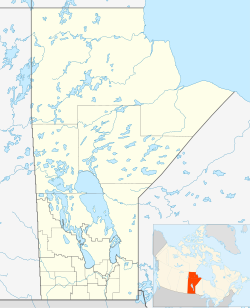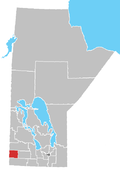History
Virden has its roots as a farming community known as Gopher Creek. However, it became a railway tent town in 1882, and grew in population due to the brick and flour industry, as well as with the discovery of oil in the 1950s. The origin of the name, Virden, allegedly arose as a misspelling of the German town Verden in the homeland of the 7th Duke of Manchester's wife, Louisa Cavendish, Duchess of Devonshire.
Geography
The town is located at the junction of the Trans-Canada Highway (also known as Highway #1) and Highway 83 (the "Palms to Pines" route) and is surrounded by the Rural Municipality of Wallace – Woodworth. Virden is a regional service centre owing in part to its location, and it has a stable commercial sector, including several restaurants, gas stations, body shops, a movie theatre, and a performing arts theatre.
Climate
| Climate data for Virden |
|---|
| Month | Jan | Feb | Mar | Apr | May | Jun | Jul | Aug | Sep | Oct | Nov | Dec | Year |
|---|
| Record high °C (°F) | 9.7
(49.5) | 17
(63) | 20
(68) | 36
(97) | 37
(99) | 42.8
(109.0) | 43.3
(109.9) | 38.5
(101.3) | 37.8
(100.0) | 34
(93) | 23.5
(74.3) | 12.8
(55.0) | 43.3
(109.9) |
|---|
| Mean daily maximum °C (°F) | −11.5
(11.3) | −7.1
(19.2) | −0.3
(31.5) | 10.5
(50.9) | 18.7
(65.7) | 22.8
(73.0) | 25.5
(77.9) | 24.6
(76.3) | 18.2
(64.8) | 11.1
(52.0) | −0.6
(30.9) | −8.9
(16.0) | 8.6
(47.5) |
|---|
| Daily mean °C (°F) | −16.7
(1.9) | −12.2
(10.0) | −5.3
(22.5) | 4.2
(39.6) | 11.9
(53.4) | 16.6
(61.9) | 19
(66) | 18
(64) | 11.9
(53.4) | 5.2
(41.4) | −5.1
(22.8) | −13.7
(7.3) | 2.8
(37.0) |
|---|
| Mean daily minimum °C (°F) | −21.9
(−7.4) | −17.3
(0.9) | −10.2
(13.6) | −2.1
(28.2) | 5.1
(41.2) | 10.3
(50.5) | 12.6
(54.7) | 11.3
(52.3) | 5.6
(42.1) | −0.8
(30.6) | −9.6
(14.7) | −14.6
(5.7) | −3
(27) |
|---|
| Record low °C (°F) | −42.2
(−44.0) | −44.4
(−47.9) | −43.3
(−45.9) | −26.7
(−16.1) | −12.2
(10.0) | −2.2
(28.0) | 0
(32) | −4.4
(24.1) | −10
(14) | −21
(−6) | −38.9
(−38.0) | −40
(−40) | −44.4
(−47.9) |
|---|
| Average precipitation mm (inches) | 21.3
(0.84) | 17
(0.7) | 26.7
(1.05) | 30.1
(1.19) | 49.6
(1.95) | 77.2
(3.04) | 66.1
(2.60) | 61
(2.4) | 49.7
(1.96) | 30.9
(1.22) | 22.7
(0.89) | 22.1
(0.87) | 474.3
(18.67) |
|---|
| Source: Environment Canada [2] |
Demographics
Historical population| Year | | |
|---|
| 1901 | 901 | — |
|---|
| 1911 | 1,550 | +72.0% |
|---|
| 1921 | 1,361 | −12.2% |
|---|
| 1931 | 1,590 | +16.8% |
|---|
| 1941 | 1,619 | +1.8% |
|---|
| 1951 | 1,746 | +7.8% |
|---|
| 1961 | 2,708 | +55.1% |
|---|
| 1996 | 3,137 | +15.8% |
|---|
| 2001 | 3,109 | −0.9% |
|---|
| 2006 | 3,010 | −3.2% |
|---|
| 2011 | 3,114 | +3.5% |
|---|
| 2016 | 3,322 | +6.7% |
|---|
| 2021 | 3,118 | −6.1% |
|---|
| [3] [4] [5] [1] [6] |
In the 2021 Census of Population conducted by Statistics Canada, Virden had a population of 3,118 living in 1,401 of its 1,508 total private dwellings, a change of -6.1% from its 2016 population of 3,322. With a land area of 8.96 km2 (3.46 sq mi), it had a population density of 348.0/km2 (901.3/sq mi) in 2021. [1]
In 2011, the median age was 42.7 years old which is 2 years older than the national average at 40.6 years old. There were 1,446 dwellings in Virden with an occupancy rate of 95.1%, and the median cost of a dwelling at $159,748, more than $100,000 lower than the national average at $280,552.
According to the 2011 National Household Survey, 96.8% of Virden residents are Canadian citizens, and about 3.2% of residents are recent immigrants (from 2001 to 2011). The racial make up of Virden is mostly Caucasian (92.0%), with a moderate Aboriginal population (5.5%); First Nations (2.0%), Métis (3.5%), and a small visible minority population (2.7%), most of which are Filipino (2.0%) or multiracial (0.5%).
This page is based on this
Wikipedia article Text is available under the
CC BY-SA 4.0 license; additional terms may apply.
Images, videos and audio are available under their respective licenses.



